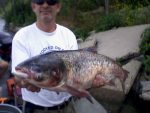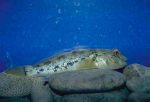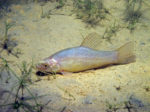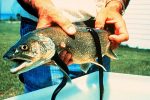What are invasive species?
For centuries human activities have helped spread plants and animals around the world, intentionally or unintentionally expanding the range of many organisms beyond their original locations. Species (a group of similar animals, plants, or other living things that share common characteristics and can interbreed and produce young) living in an area where they are naturally and historically found are often called “native” species. Native species have adapted to their local habitats through a continuing interaction between their inherited characteristics and their environment. For thousands of years, natural barriers determined where organisms lived and helped defined their habitat, creating dynamic, natural ecosystems. Within their natural ecosystems, native organisms develop unique balanced relationships with both their physical environments and with the other organisms around them. As human activities have expanded, things have changed.
The ability to move people and products around the globe has been the basis of some of mankind’s greatest achievements, but increased mobility has also greatly increased the transfer of all types of organisms to new environments where they were not previously found. Species introduced into an area where they did not previously live are called “non-native” species, sometimes also known as exotic, nuisance, or non-indigenous species. Often, species introduced into a new wild environment will be unable to establish a viable population and will disappear with no ill effects. However, sometimes newly introduced species will thrive, outcompeting native species and destroying fragile ecosystems. Non-native species that damage the environment or disrupt existing ecosystems, or that result in economic loss or endanger human health, are generally referred to as “invasive” species. Many types of organisms, from plants to animals to microbes can be invasive. Invasive species can be introduced from other countries or from other parts of the same country.
Why are invasive fish species a problem?
Invasive fish species are a growing problem nationwide, especially in coastal regions and in the Great Lakes and surrounding areas. Invasive fish species can cause serious environmental problems and cause significant economic losses, often rapidly disrupting the fragile balance of natural ecosystems, and threatening the diversity and abundance of native aquatic species. The resulting loss of native fish can lead to important economic consequences, affecting a wide range of commercial, agricultural, aquacultural, and recreational activities. Globally, the introduction and spread of non-native species around the world has been described as a major threat to a stable natural environment and to global species biodiversity.
The introduction of invasive fish species is of particular concern because of the ease and frequency of waterway contamination by non-native fish. Aquatic species are often introduced into new areas as a result of the dumping of large amounts of ballast water (the water that is pumped into huge tanks to stabilize unloaded ships, and discharged at the next port of call, along with any surviving organisms) by large ships. Around the world, millions of tons of ballast water are exchanged daily, transporting within it aquatic species from microscopic plankton to fish. On a smaller scale, commercial activities such as aquaculture and the aquarium trade in exotic fish species can sometimes lead to the accidental or purposeful release of fish species into areas where they have never been found before. Even well-intentioned plans to introduce non-native species to control biological problems have backfired and resulted in serious damage by invasive species. For example, the introduction of grass carp to control the spread of unwanted aquatic plants has lead to the destruction of native plant species in inland lakes, resulting in tremendous damage to lake ecology and ecosystems at all levels. Recreational boaters and fishermen can also contribute to the problem by transporting fish (even baitfish) between rivers and lakes, resulting in cross-contamination of previously unaffected waters. Owners of household aquaria can potentially contaminate a waterway simply by dumping the contents of their home aquarium into a lake or stream. While nuisance species are most commonly first introduced into navigable waters, recreational users can easily spread them to pristine rivers, streams, lakes, ponds, and reservoirs.
Invasive species we’re tracking
Sea lamprey (Petromyzon marinus)
|
|
|
Sea lamprey are native to the Atlantic Ocean but were introduced into the Great Lakes in the 1800s through a series of manmade locks and shipping canals. By the late 1940s all of the Great Lakes contained large populations of sea lamprey that caused serious damage to lake trout and other important fish species.
For part of its life cycle, the sea lamprey feeds on the blood of host fish. Sea lamprey have a large sucking disc for a mouth, filled with sharp teeth and a file like tongue. They use the sucking disc and teeth to attach to prey fish, and rasp through the scales and skin to feed on blood and other body fluids, often resulting in the death of the prey. The lamprey attack is so destructive that only about 1 out of 7 fish will survive an attack. During its life, which can last from an average of 6 to as long as 20 years, a single lamprey can kill large numbers of native lake and rainbow trout, whitefish, chubs, walleye, and catfish.
The economic effect of this invasive species has been enormous. For example, before the spread of the sea lamprey invasion, the United States and Canada harvested about 15 million pounds of lake trout from the upper Great Lakes each year. By the 1960s the total lake trout catch had dropped to only about 300,000 pounds. In Lake Michigan alone the catch dropped from 5.5 million pounds in 1946 to 402 pounds in 1953 (data from the Great Lakes Fishery Commission). Today there is an ongoing sea lamprey control program that is helping to reduce sea lamprey populations in many areas, but vigilant monitoring is still a key factor in controlling this highly destructive invasive species.
Asian carp (grass carp – Ctenopharyngodon idella; silver carp – Hypophthalmichthys molitrix; bighead carp – Hypophthalmichthys nobilis; black carp – Mylopharyngodon piceus)

Asian carp were originally brought to the United States in the 1970s to help control algae growth on catfish farms and in wastewater treatment ponds. Two species of Asian carp were released from southern aquaculture facilities following flooding in the 1990s, and the invasion has been spreading north along the Mississippi ever since. In some areas of the Mississippi River,
Asian carp have become the most abundant fish species, having already out-competed native fish. Asian carp have been identified in the canals connecting the Mississippi River to the Great Lakes. Unfortunately, Asian carp, which can grow up to four feet long and weigh more than 100 pounds, have no natural predators in their new environment. A single carp can eat up to 5 -10% of their body weight in plankton each day. By consuming nearly all of the available plankton, the primary food source for most of the native fish, the Asian carp can rapidly wipe out entire populations of native fish.
In an effort to decrease the spread of Asian carp into new rivers and lakes, the U.S. Fish and Wildlife Service has placed several species of Asian carp to the federal list of injurious wildlife, making it illegal to transport live Asian carp, including viable eggs or hybrids of the species, across state lines except by special permit for zoological, education, medical, or scientific purposes.
Round goby (Neogobius melanostomus)

Round goby were introduced into the Great Lakes through the ballast water from large cargo ships and were first identified here in 1990. Since their introduction, round goby have caused significant ecological and economic problems. They have spread throughout the Mississippi River drainage area and into tributaries of the Great Lakes, including a sighting in one of the New York Finger Lakes (Cayuga Lake).
Round goby, which are bottom dwellers, compete very successfully with native bottom dwelling species like sculpins and darters for food, habitat, and spawning areas, and can cause substantial decreases in local populations of native fish. They also prey on small fish and eat the eggs and fry of larger native fish like lake trout.
The increased presence of round goby has been shown to potentially impact the food chain supplying recreationally important fish like walleye and smallmouth bass. It has been noted that round goby eat large amounts of zebra mussels, which in the short term may seem like an unexpected benefit. But, as with most environmental and ecological issues, it is important to look at the broad picture. Despite their large appetites, it is unlikely that round goby will have a significant impact on zebra mussel populations. Equally important, the zebra mussels eaten by round goby contain large amounts of various toxins that are found throughout the Great Lakes. Following intake of the zebra mussels, the toxins become concentrated in the goby, which are in turn eaten by a variety of sport fish, including smallmouth and yellow bass, walleyes, yellow perch, and brown trout. This food chain can lead to high concentrations of dangerous toxins in sport fish that are eaten by humans, increasing health concerns related to consuming sport fish.
Northern snakehead (Channa argus)

Northern snakehead fish are native to parts of China, Russia, and the Korean peninsula, where they are considered a valuable food fish. Snakeheads are also popular exotic additions to home aquariums and have been introduced into United States waters primarily by aquarium owners discarding their unwanted pets into local waterways. The fish may also have been intentionally released to provide a local source for fishermen interested in catching snakehead for consumption. As a result, the northern snakehead has successfully established wild breeding populations in some parts of the United States and is gradually expanding its range.
Snakeheads can live in freshwater lakes, ponds, rivers, streams, and wetlands, including slow moving or even stagnant water. They can also survive cold winters. Northern snakehead fish can spread by swimming in water, but they can also breathe air. Therefore, they are capable of surviving on land for up to four days, as long as they are wet, and they can move up to ¼ mile on land by wriggling their bodies and using their fins.
Northern snakeheads are aggressive predators that grow up to 4 feet in length, with large mouths and sharp canine-like teeth. Invasive snakeheads thrive in the absence of their natural enemies, with a single female capable of laying up to 150,000 eggs in just 2 years. Adult snakeheads eat other native fish, small amphibians, reptiles, crustaceans, and even some birds and mammals, while juvenile snakeheads pose a significant threat to zooplankton, larvae, small fish, and crustaceans. Snakeheads also compete with native species for food and habitat.
Because snakeheads are considered injurious wildlife, it is illegal to import the fish or viable eggs from other countries, or to transport them across state borders. Efforts aimed at preventing further spread are important because of the potential ecological, environmental, and economic effects of this invasive species. Establishment of the northern snakehead in the United States could result in serious ecological and environmental damage, costing millions of dollars in management efforts and impacting aquaculture and the sport fishing industry.
White perch (Morone americana)

White perch are native to the east coast of the United States and Canada and are often found in fresh, brackish and coastal waters. They have invaded other areas in the United States, primarily through bait fish release and movement through watersheds. Access to the Great Lakes probably occurred via the Welland Canal and the Erie Barge Canal starting in the 1930s.
White perch reproduce rapidly since they can spawn multiple times per year under optimal conditions, and can successfully breed in a variety of water conditions. There are several important negative impacts associated with the introduction of white perch, including predation, competition for food, resources, and habitat, and hybridization. Fish eggs are a substantial part of the white perch diet, and predation on the eggs of walleyes and white bass have caused a decline in some fisheries. White perch also eat small fish like minnows, and successfully compete for food with native species such as yellow perch, white bass, and black bullhead. As a result, a decrease in the abundance of native fishes often follows the introduction of white perch. White perch also consume large amounts of zooplankton, which may contribute to algal blooms in waters where they become heavily established.
White perch are closely related to white bass, but are normally not found in the same waters. When non-native white perch are introduced into an area where white bass are found, fertile hybrid offspring can be produced that are capable of reproducing with the parent species, potentially diluting the gene pool of both parent species. Because of the problems resulting from the introduction of non-native white perch, possession of live white perch is illegal in several states, and release of captured white perch back into the water is not recommended.
Asian swamp eel (Monopterus albus)

Asian swamp eels are native to Asia and were first introduced into the continental United States from multiple geographic areas in the mid 1990s as a food source and also for use in home aquaria. Escape from fish farms and intentional release of pet fish have resulted in the establishment of wild populations in Florida and Georgia. Although not yet found in New York state, the presence of swamp eel was confirmed in New Jersey in 2008.
The swamp eel lives in fresh water, including stagnant waters, marshes, shallow wetlands, streams, rivers, lakes and ponds, but can also tolerate brackish and saline conditions. Swamp eels can survive cold temperatures and a wide range of oxygen levels since they can absorb up to 25 percent of the oxygen they need from the air. As a result, swamp eels can migrate short distances over land, increasing their ability to disperse to new habitats. They have a voracious appetite and eat a wide range of prey, competing with native species for food, and potentially disrupting fragile ecosystems.
Swamp eels are hermaphroditic, with all young initially being female. As they mature, some fish become male, but are capable of reverting to the female form when females become rare. Females can lay up to 1000 eggs each time they spawn, and spawning can occur throughout the year. This reproductive flexibility can provide a survival advantage over native fish. To help limit the spread of this invasive species, the United States Geological Survey discourages catching and transporting the eel for use as bait, food, or aquarium pets.
Tench (Tinca tinca)

Tench, a member of the minnow/carp family, is a freshwater game fish native to Europe that has been introduced to many different countries around the world, including the United States. Tench are potamodromous, meaning they migrate and complete their life cycle in fresh water only. Tench average about 10 inches in length, but can live up to 20 years and grow to nearly 3 feet in length and weigh up to 16 pounds. Tench mature between 2 and 7 years of age and breed in the late spring or summer. Females lay a new clutch of eggs every 15 days for about 2 months. Tench prefer to live in shallow lakes and rivers in areas of heavy vegetation with a weedy, muddy bottom. Tench can survive in low-oxygen environments and in some areas spend the winter buried in mud. Tench are voracious eaters, consuming huge quantities of insect larvae, snails, mollusks, plants, algae, and organic debris that native species depend on. Tench also eat the eggs of other fish species, placing further stress on native fish like yellow perch and the copper redhorse that are already struggling with pollution and habitat loss. Tench are also a source of fish parasites that can spread to other species. In 2018 the Great Lakes St. Lawrence Governors & Premiers coalition added tench to the “least wanted” fish list and the St. Lawrence–Eastern Lake Ontario Partnership for Regional Invasive Species Management (SLELO-PRISM) in New York is trying to raise awareness of the impending problems that could result from invasive Tench.
Tench were first introduced into the Great Lakes basin in the 1980s, likely after escaping from aquaculture ponds in Quebec, and became established in Lake Champlain in 2000.Tench have expanded their range into Lake St. Francis in the St. Lawrence Seaway and are steadily pushing upstream into Lake Ontario. Unfortunately, habitat conditions that were expected to limit feeding and spawning have not halted their expansion. The spread of tench has also been facilitated by illegal fish transport, illegal pond stocking, and use of tench as baitfish. Currently tench are a potential problem, but not yet a direct threat to New York waterways. However, tench are already found in the Great Lakes, and given their ability to spread and thrive in a wide variety of conditions, tench are poised to become a major invasive problem in New York waters. Increasing community awareness, developing strategies to slow the invasion, and early monitoring are important factors in limiting the tench invasion while there is still time.


